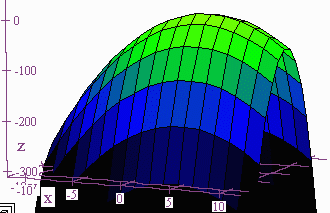Locating and Classifying Local Extrema
Definition of Relative Max and Min
We now extend the definition of relative max and min to functions of two
variables.
|
Definition 1. A function f(x,y) has a relative maximum at (a,b) if there is a small circle centered at (a,b) such that f(a,b) > f(x,y) 2. There is a relative minimum at (x,y) if f(a,b) < f(x,y) for all (x,y) in the a small circle centered at (a,b). |
For differentiable functions of one variable relative extrema occur at a point
only if the first derivative is zero at that point. A similar statement
holds for functions of two variables, but the both partial derivatives must be
0.
|
Theorem If f(x,y) has a relative maximum or minimum at a point P, fx(P) = fy(P) = 0 |
Example
Let
f(x,y) = x2 + xy - 2y + x - 1
then
fx(x,y) = 2x + y + 1
fy(x,y) = x - 2
so that
x - 2 = 0
or
x = 2
Hence
2(2) + y + 1 = 0
so
y = 5
A possible extrema is (2,-5).
Notice that just as the vanishing of the first derivative does not guarantee a
maximum or a minimum, the vanishing of the partial derivatives does not guarantee a
relative extrema either. But once again, the second derivative comes to
the rescue. We begin by defining a version of the second derivative for
functions of two variables.
|
Definition We call the matrix:
the hessian
and its determinant is |
Now we are ready to state the second derivative test for functions of two variables. This theorem helps us to classify the critical points as maximum, minimum, or neither. In fact their is a special type of critical point that is neither a maximum nor a minimum, called a saddle point. A surface with a saddle point is locally shaped like a saddle in that front and back go upwards from the critical point while left and right go downwards from the critical point.
Theorem (Second Derivative Test For Functions of Two Variables)
If gradf = 0
we have the following
|
Example:
Let
f(x,y) = -x2 - 5y2 + 8x - 10y - 13
then
fx = -2x + 8
fy = -10y - 10
has zeros at (4,-1)
we have
fxx = -2,
fyy = -10, and fxy = 0
Hence
D = (-2)(-10) - 0 > 0
so f has a relative maximum at (4,-1)

Example: Let
f(x,y) = 4xy - x4 - y4
then
fx = 4y - 4x3
fy = 4x - 4y3
We solve:
4y - 4x3 = 0
so that
y = x3
Hence
4x - 4(x3)3 = 0
or
x - x9 = 0
so that
x = 1
or x = 0 or
x = -1
plugging these back into
y = x3
gives us the points
(1,1), (0,0) and
(-1,-1)
We have
fxx = -12x2,
fyy =
-12y2, and fxy = 4
Hence
D = 144x2y2 - 16
We write the table:
| Point | D | fxx | Type |
| (1,1) | 126 | -12 | Max |
| (0,0) | -16 | 0 | Saddle |
| (-1,-1) | 126 | -12 | Max |

Minimizing Distance
Example
Find the minimum distance from the point (2,1,4) to the plane
x + 2y + z = 5
Solution:
We minimize the square of the distance:
S = (x - 2)2 + (y - 1)2 + (5 - x - 2y - 4)2
We find the partial derivatives and set them equal to
0:
fx = 2(x - 2) - 2(5 - x - 2y - 4)
fy = 2(y - 1) - 2(5 - x - 2y - 4)
so
2x - 4 - 10 + 2x + 4y + 8 = 0
and 2y - 2 - 10 + 2x + 4y + 8 = 0
simplifying gives
4x + 4y - 6 = 0
and 2x + 6y - 4 = 0
or
2x + 2y - 3 = 0
and 2x + 6y - 4 = 0
subtracting the first from the second, we get:
4y - 1 = 0
so
y = 1/4
Hence
x = 7/4
Finally, we have
s = (7/4 - 2)2 + (1/4 - 1)2 + (5 - 7/4- 2(1/4) -
4)2
= 35/16 = 2.1875
Taking the square root gives that minimum distance of 1.479.
Note that by geometry, this must be the minimum distance, since the minimum
distance is guaranteed to exist.
Back to the Math 117 Home Page
Back to the Math Department Home
e-mail Questions and Suggestions
